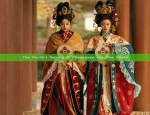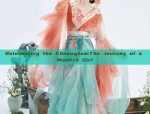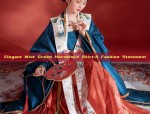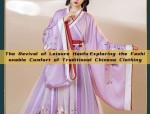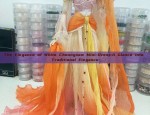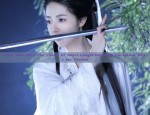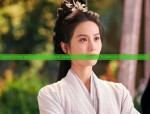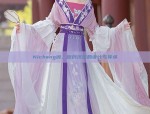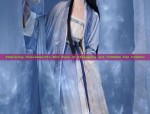Blooming in the Rain:The Splendor of Hanfu,a Traditional Chinese Clothing
In the realm of Chinese culture, Hanfu stands as a symbol of ancient elegance and beauty. It is not merely a clothing; it is an embodiment of thousands of years of history and tradition. When the flowers bloom in the rain, their beauty is enhanced by the droplets, just as Hanfu is enhanced by its rich cultural heritage.

The essence of Hanfu can be traced back to the Han dynasty (206 BC – 220 AD), when it was worn by the commoners as well as the nobility. It is a traditional costume that encompasses a wide range of styles and designs, each reflecting a unique aspect of Chinese culture and history. The intricate patterns, vibrant colors, and meticulous craftsmanship are the hallmark of Hanfu.
The beauty of Hanfu lies in its simplicity and elegance. The design elements are often inspired by nature, such as flowers, birds, clouds, and water. Each element is meticulously crafted into the clothing, creating a harmonious blend of nature and culture. The rain, which is a common occurrence in many parts of China, adds to the beauty of these designs, making them come alive with a newfound vibrancy.
The intricate details and patterns of Hanfu are not just for aesthetics; they also carry deep cultural meanings. For instance, the lotus flower, which is often featured in Hanfu designs, represents purity and innocence. Similarly, the dragon and phoenix symbols signify power and good fortune. These symbols are not just decorative; they also reflect the wearer’s values and beliefs.
The evolution of Hanfu has been influenced by various factors, including historical events, cultural exchanges, and fashion trends. However, despite these changes, the core elements of Hanfu have remained unchanged, preserving the essence of Chinese culture.
Today, Hanfu has gained popularity not only in China but also across the globe. Many people, especially those who are interested in Asian culture and history, are fascinated by this traditional clothing. It is worn during festivals and cultural events, as well as for everyday wear. The appreciation for Hanfu has also led to the development of modern variations that are more practical and suitable for modern lifestyles.
In conclusion, Hanfu is not just a clothing; it is a symbol of Chinese culture and history. It embodies thousands of years of tradition and history, reflecting the values and beliefs of its wearer. The beauty of Hanfu is enhanced by the rain, which brings out its vibrant colors and intricate designs. As Hanfu continues to evolve and gain popularity, its essence as a symbol of Chinese culture will remain unchanged.
Moreover, Hanfu provides an excellent opportunity for cultural exchange and understanding. As it gains popularity across the globe, people from different cultures can learn about Chinese history and culture through this traditional clothing. It opens up a window for people to understand and appreciate the rich cultural heritage of China.
In addition to its cultural significance, Hanfu also serves as a form of self-expression. Just like flowers blooming in the rain, each piece of Hanfu tells a story about its wearer’s personality and style. It allows individuals to express their unique identity and style through their choice of clothing.
As Hanfu continues to evolve and adapt to modern lifestyles, it remains faithful to its roots while incorporating modern elements. This balance between tradition and modernity is evident in the design elements, patterns, and colors used in modern Hanfu. It not only preserves the essence of Chinese culture but also adapts to the needs of modern wearers.
In conclusion, Hanfu is not just a clothing; it is a symbol of Chinese culture that embodies thousands of years of history and tradition. Its beauty is enhanced by the rain, reflecting its intricate designs and vibrant colors. As it gains popularity across the globe, Hanfu provides an excellent opportunity for cultural exchange and understanding, allowing people to appreciate the rich cultural heritage of China.

 Previous Post
Previous Post

